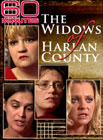1939 Harlan County
Mine Strike

Harlan County
USA (DVD) Re:
6-30-1973
Brookside Mine
Strike
Harlan County
War (DVD)
The Widows of
Harlan County
(DVD)In the 1920s miners were joining unions in increasing numbers - for the most part they joined the United Mine Workers of America (UMWA) led by John L. Lewis at the time. In most places as soon as miners joined, they were blacklisted by mine operators and evicted from their company homes. That is what happened in eastern Kentucky in 1931, when mine operators locked out workers for voting to unionize.
Locked out and evicted miners were not making money to feed their families and there was no one to provide aid to them. There were no state or federal safety nets back then.
On May 5, 1931 the pot boiled over. In Harlan County, Kentucky heavily armed deputies and company men, called gun thugs by miners, confronted disgruntled union men on a road near Evarts. The coal miners, lean and tough from Kentucky mountain life, knew, how to fight back. No one knows, who fired the first shot, but when it was over, four were dead - three deputies and one miner- with several more wounded.
The next day soldiers entered Harlan to end the violence. The troops quickly joined forces with local rulers and commenced strikebreaking activities. By June the strike was over. Union leaders were banished from the mines and 44 men stood trial.
Public out-cry, when events became known nationally, led a group of authors, including Theodore Dreiser and John Dos Passos, to visit the area to report on conditions.
Under pressure the Governor later admitted: there exists a virtual reign of terror in Harlan County, financed in general by a group of coal mine operators in collusion with certain public officials. The victims of this reign of terror are the coal miners and their families. It's a monster-like reign of oppression, whose tentacles reached into the very foundation of the social structure and even into the church of God. The homes of union miners and organizers were dynamited and fired into. It appears that the principal cause of existing conditions is the desire of the mine owners to amass for themselves fortunes through the oppression of their laborers, which they do through the sheriff's office.
Sadly, Harlan County's troubles persisted through most of the 1930s, still known throughout the region as the "Bloody Harlan" years. In fact, Harlan's Depression-era struggle turned out to be one of the most bitter and protracted labor disputes in American history. The decade-long conflict between miners and the coal operators, who adamantly resisted unionization, was violent - miners (13) and gun thugs lost their lives.
The Harlan County class war provided the inspiration for Florence Reece's "Which Side Are You On?" In it she captured the spirit of her times with blunt eloquence.
As long as a single ton of recoverable coal remains underneath the surface of eastern Kentucky, men and their families will likely be exploited to mine it.
Note: in 1973-74 another long, bitter strike transpired at Harlan's Brookside mine, when the Duke Power Company refused to sign a UMWA contract. The strike, which is documented in the award-winning movie "Harlan County, USA", also led to bloodshed.
Bloody Harlan: http://www.bloodyharlan.com